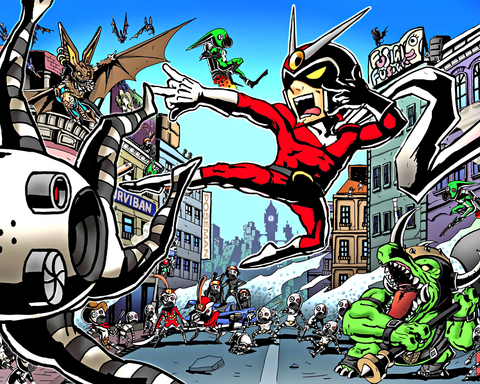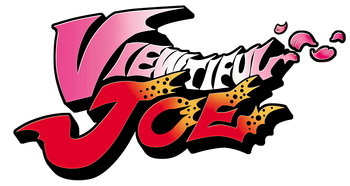Tag: sourceedit |
Tag: sourceedit |
||
| Line 24: | Line 24: | ||
== Gameplay == |
== Gameplay == |
||
| − | [[Image:VJCoverArt.png|right|thumb| |
+ | [[Image:VJCoverArt.png|right|thumb|480px|''U.S.'' Cover Art]] |
Viewtiful Joe's gameplay is very unusual, and draws inspiration from classic side-scrolling brawlers such as ''[[w:c:techno:River City Ransom|River City Ransom]]'' and ''[[w:c:doubledragon:Double Dragon|Double Dragon]]''. Joe has no blocking moves when fighting; he only can dodge by jumping or ducking. Usually, by successfully jumping or ducking, the foe that attacked him will be dazed, leaving the enemy wide open for attack. |
Viewtiful Joe's gameplay is very unusual, and draws inspiration from classic side-scrolling brawlers such as ''[[w:c:techno:River City Ransom|River City Ransom]]'' and ''[[w:c:doubledragon:Double Dragon|Double Dragon]]''. Joe has no blocking moves when fighting; he only can dodge by jumping or ducking. Usually, by successfully jumping or ducking, the foe that attacked him will be dazed, leaving the enemy wide open for attack. |
||
===<small>'''VFX'''</small>=== |
===<small>'''VFX'''</small>=== |
||
Revision as of 17:41, 26 September 2015
Viewtiful Joe is the first of four games in the Viewtiful Joe series. It was developed by Capcom's Production Studio 4 design team "Team Viewtiful". The other games in the series, including the PS2 port of the first game, have been made by Clover Studio. Atsushi Inaba headed the development of all the Viewtiful Joe games (first at Capcom Production Studio 4, then at Clover Studio).

Viewtiful Joe - Trailer
Trailer
The first game was developed exclusively for the Nintendo GameCube in 2003, but was later ported to the PlayStation 2 in 2004. The Japanese version of the PS2 release is titled Viewtiful Joe: A New Hope, a tongue-in-cheek reference to the movie Star Wars Episode IV: A New Hope. Characters illustrated by Kumiko Suekane.
Characters
- Viewtiful Joe
- Silvia
- Alastor
- Captain Blue
- Fire Leo
- Biankies
- Dante - (PS2 version only)
- Trish - (PS2 version only)
- Charles III - is an arrogant and snobbish bat-like agent.
- Hulk Davidson - is a rhino-like agent who was responsible for Captain Blue's scar.
- Gran Bruce - is a shark-like agent, who is lower on the intelligence scale than most of the other Jadow.
- Another Joe - Actually Alastor in disguise. Looks just like Joe, but with a dark pink visor.
Plot
While Joe and his girlfriend Silvia are at the theater during a date, Silvia is kidnapped by the movie's antagonist and taken into the world of the movies: Movieland. Joe is able to follow Silvia, after being picked up and taken into Movieland by the robot Six Majin. Inside the movie, Joe must rescue Silvia from the evil Jadow, the game's organization of villains. To help him, Captain Blue entrusts him with a V-Watch, telling Joe to transform into a superhero upon saying "Henshin" (Japanese for 'Transformation'), but Joe made it into his personal catchphrase, "Henshin-a-go-go, baby!"
Gameplay

U.S. Cover Art
Viewtiful Joe's gameplay is very unusual, and draws inspiration from classic side-scrolling brawlers such as River City Ransom and Double Dragon. Joe has no blocking moves when fighting; he only can dodge by jumping or ducking. Usually, by successfully jumping or ducking, the foe that attacked him will be dazed, leaving the enemy wide open for attack.
VFX
Joe has three 'VFX' (Viewtiful Effects) powers, which are designed to emulate camera tricks seen in movies such as The Matrix:
- Slow - causes Joe's attacks to be more powerful, as well as increasing his reflexes and giving him the ability to dodge most attacks. While in Slow, striking a dazed foe sets up all enemies on the screen for a chain reaction, causing all points accrued during the duration of Slow to be multiplied by the number of enemies struck. If used deftly, Slow will accumulate a very large number of points due to the multiplier effect. If Joe is attacked while in Slow, he will automatically do a dodge move, and will lose a large chunk of his remaining VFX power.
- Mach Speed - allows Joe to run at incredible speed, create multiple after-images of himself when he unleashes a flurry of attacks, and can cause his attacks to envelop himself in a temporary heat shield, which will render him immune to flame attacks and set enemies on fire when struck. When used in tandem with Slow, Mach Speed only increases Joe's walking speed while in slow. It also allows "rapid" punches to be used, by holding the attack button.
- Zoom - gives Joe access to a new group of attacks and will power up his normal attacks, as well as "dazzling" all of the lesser foes in proximity to Joe into paralysis. Joe's punch is replaced with the "Red Hot One Hundred", a flurry of fists (different from Mach Speed). Joe's kick is replaced with an energetic spin kick, where he levitates in the air as he spins repeatedly. Jumping causes Joe to corkscrew into the air, damaging anything in his path. If the player zooms in while in the air, Joe will careen towards the ground feet first and send shockwaves out from the point of impact.
All of these are used in combat, and to solve the game's puzzles. Two of Joe's attack powers can be used at the same time, Slow and Zoom, Mach Speed and Zoom, or Slow and Mach Speed (when using Slow and Mach Speed together, Joe moves at a normal speed while everything else is slowed). The most powerful attack in the game, the "Slow Zoom Red Hot One Hundred" (SlowZ-RHOH), is done by enabling Slow, Zooming, and then punching the enemy. Using Mach Speed while attacking speeds the attack up slightly.
All of the VFX powers are required to get past at least one area in the game. Joe has a VFX meter, which empties as he uses his powers. If it runs out, Joe reverts to his normal state until the first bar of the meter refills. In his normal state, Joe takes double damage, has weaker attacks, loses the double jump ability and can no longer use his VFX powers. The bar can be extended by collecting various film cans scattered throughout the stages. For every fifty collected, a small extension a third the length of the initial VFX bar is added, up to five extensions. Picking up small blue juice cans gives a small boost to the VFX bar (and can extend beyond the length of the VFX bar available), large blue bottles fill up a significantly larger portion, and red bottles give infinite VFX power for a limited time.
Development
Viewtiful Joe was developed by the design staff "Team Viewtiful", a part of Capcom Production Studio 4. The game was announced in late 2002 as part of the "Capcom Five", a line-up of five then-upcoming GameCube games to introduce new content to the console. It was directed by former Capcom alumnus Hideki Kamiya, whose previous credits include the planning of Resident Evil and Resident Evil 2 and the direction of Devil May Cry. It was produced by Atsushi Inaba, who previously worked on the Ace Attorney series and Steel Battalion. In its earliest stages of development, Viewtiful Joe went under the working title "Red Hot Man", but the name was changed due to copyright conflicts with the American rock band Red Hot Chili Peppers. Viewtiful Joe's development team initially consisted of six people working under a twelve-month deadline. As work continued, the size of the team grew, and development ended up taking a full 21 months to complete. The game was conceived as a "staff-focused project" aimed at increasing the skill of its creators, specifically director Kamiya.
Inaba stated that the team wanted to create a challenging game with stunning visuals and fluid gameplay. As a lifelong fan of superheroes, Inaba's aim was to combine traditional Japanese tokusatsu with American comic books. The character designs created by Kumiko Suekane were inspired specifically by 1960s and 1970s Japanese-costumed tokusatsu television shows such as Kamen Rider and Ultraman. Graphically, the game adopted a 2D side-scrolling style mixed with 3D cel-shaded animation. Despite many games in the then-modern industry shying away from 2D graphical formats, Inaba stated that the team was able to "breathe new life into the genre because [they] were using a new stylistic way that hasn't been seen before". The team chose the GameCube as its platform because of their target audience and because it lent itself well to Viewtiful Joe's gameplay. It is said that director Kamiya based Joe's run animation on how he got to work, and the bosses of the game are based on Capcom executives.[citation needed]
The musical score for Viewtiful Joe was co-composed by Masakazu Sugimori and Masami Ueda. It was released alongside the score for Viewtiful Joe 2 on a double album titled Viewtiful Joe + Viewtiful Joe 2 Original Soundtrack in Japan on 22 December 2004 by Suleputer. A music video is played within the game featuring a rap vocal song titled "Viewtiful World" composed by D.A.I. The video features a group of people, including Inaba himself, motion captured as some of the game's characters. On 11 June 2003, Avex released the video on DVD and released the song as a single. Both the North American and Japanese releases of Viewtiful Joe feature English voice acting in order to keep a "western comic book feel to [the game]." Voice-over work in Viewtiful Joe was provided by Soundelux Design Music Group. Voice actors for the game include Dee Bradley Baker, Christina Puccelli, Gregg Berger, Mikey Kelley, Roger Rose, and Kevin Michael Richardson. Director Hideki Kamiya provides the voice for Six Machine.
A budget re-release of the game for the GameCube titled Viewtiful Joe: Revival was released in Japan in late 2003, adding a "Sweet Mode" to decrease the difficulty setting from the original game's "Kids Mode". A PlayStation 2 port of Viewtiful Joe was released by Clover Studio in 2004. It was released in Japan with the subtitle A New Hope. The release added the character Dante of Devil May Cry fame as an unlockable character. The PlayStation 2 version does not feature progressive scan seen in the GameCube version. The game was also re-released under Nintendo's GameCube Player's Choice label in 2004 in North America and Europe.
Trivia
- Before the battle with Hulk Davidson, Joe is asked "So what's with the V-Watch on your arm? What, you think you're some kinda Mega Man or something?", referring to the famous little blue robot.
- At the start of the level "Midnight Thunder Boy", Joe talks to his fists, saying "Time to go to work, guys!" This same line is said by Dante at the start of Devil May Cry except that he is talking to his guns Ebony & Ivory.














